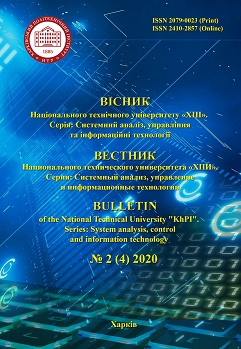DECLARATIVE-TEMPORAL APPROACH TO THE CONSTRUCTION OF EXPLANATIONS IN INTELLIGENT INFORMATION SYSTEMS
DOI:
https://doi.org/10.20998/2079-0023.2020.02.09Keywords:
explanation, knowledge, intelligent information system, temporal rules, requirements for explanationAbstract
The subject of the research is the processes of constructing explanations for the solutions proposed by the intelligent information system. The explanation provides in an orderly manner knowledge about the solution of the intelligent system, taking into account the context of its construction. The aim is to develop an approach to constructing a description of knowledge to provide an explanation that provides the ability to interpret intelligent system solutions online, using the most relevant dependencies on the state of the subject area and user needs. To achieve this goal, the following tasks are solved: setting a generalized problem of forming an explanation and principles for its solution; definition of principles of construction of the description of knowledge for explanation; developing an approach to constructing an explanation based on the integration of a declarative description of the subject area and a temporal description of the decision-making process. A generalized formulation of the problem of forming an explanation in the form of finding an interpretation model is proposed, which makes it possible to minimize the inaccuracy of the description of the decision-making process regarding the model of the intelligent system functioning process in the conditions of explanation complexity. The principles of solving the problem of constructing an explanation are formulated, which provide for the consistent formulation of a declarative description of the subject area in the form of an appropriate ontology, as well as a description of the decision-making process in the intellectual system based on temporal rules. A declarative-temporal approach to constructing an explanation in an intelligent information system is proposed. According to this approach, the tasks of detailing the goals of the explanation within the defined concept are consistently solved on the basis of the ontology of the subject area, the explanation is formed taking into account the structure of the intelligent system and the interaction of its components, personalization of the explanation according to user preferences. This approach makes it possible to update the interpretation, which creates the conditions for building explanations online.References
Swartout W., Moore J. Explanation in Second Generation Expert Systems. David J.-M., Krivine J.-P., Simmons R. (ed) Second generation expert systems, Springer-Verlag. 1993, pp. 543–585.
Tintarev N., Masthoff J. A survey of explanations in recommender systems. The 3rd international workshop on web personalisation, recommender systems and intelligent user interfaces (WPRSIUI'07). 2007, pp. 801–810.
Arrieta A. B., Rodriguez N. A., Ser J.D., Bennetot A., Tabik S. González A. B., García S., Gil-López S., Molina D., Benjamins V.R., Chatila R., Herrera F. Explainable Artificial Intelligence (XAI): Concepts, Taxonomies, Opportunities and Challenges toward Responsible AI. Information Fusion, Elsevier B.V. 2019, pp. 1–72.
Aggarwal, C. C.: Recommender Systems. Springer, New York. 2017, 498 p.
Núñez H., Angulo C., Català A. Rule-based learning systems for support vector machines. Neural Processing Letters. 2006, vol. 24. pp. 1–18.
Cunningham P., Doyle D., Loughrey J. An evaluation of the usefulness of case-based reasoning explanation. Proceedings of the International Conference on Case-Based Reasoning (ICCBR 2003). Trondheim, Springer. 2003, p. 122–130.
Donadello I., Dragoni M., Eccher C. Persuasive explanation of reasoning inferences on dietary data. First Workshop on Semantic Explainability ISWC 2019. 2019, pp.1–16.
Donadello I. Semantic image interpretation-integration of numerical data and logical knowledge for cognitive vision. Information and Communication Technology, University of Trento, 2018, pp. 141.
Chalyi S. F., Leshchynskyi V. O., Leshchynska I. O. Modelyuvannya poyasnen shodo rekomendovanogo pereliku ob’yektiv z urahuvannyam temporalnogo aspektu viboru koristuvacha [Modeling explanations for the recommended list of items based on the temporal dimension of user choice]. Sistemi upravlinnya, navigaciyi ta zv’yazku [Control, Navigation and Communication Systems], 2019, vol. 6, no. 58, pp. 97–101.
Daher J, Brun A., Boyer A. A. A review on explanations in recommender systems. Technical Report. LORIA Université de Lorraine. 2017, pp. 26.
Levykin V., Chala O. Method of determining weights of temporal rules in markov logic network for building knowledge base in information control system. EUREKA: Physics and Engineering. 2018, vol. 5, pp. 3–10.
Levykin V., Chala O. Development of a method for the probabilistic inference of sequences of a business process activities to support the business process management. Eastern-European Journal of Eenterprise Technologies. 2018, vol. 5/3(95), pp. 16–24.
Chalyi S., Leshchynskyi V., Leshchynska I. Method of forming recommendations using temporal constraints in a situation of cyclic cold start of the recommender system. EUREKA: Physics and Engineering. 2019, vol. 4, pp. 34–40.
Chalyi S., Pribylnova I. The method of constructing recommendations online on the temporal dynamics of user interests using multilayer graph. EUREKA: Physics and Engineering. 2019, vol. 3, pp. 13–19.
Downloads
How to Cite
Issue
Section
License
Copyright (c) 2020 Bulletin of National Technical University "KhPI". Series: System Analysis, Control and Information TechnologiesAuthors who publish with this journal agree to the following terms:
- Authors retain copyright and grant the journal right of first publication with the work simultaneously licensed under a Creative Commons Attribution License that allows others to share the work with an acknowledgement of the work's authorship and initial publication in this journal.
- Authors are able to enter into separate, additional contractual arrangements for the non-exclusive distribution of the journal's published version of the work (e.g., post it to an institutional repository or publish it in a book), with an acknowledgement of its initial publication in this journal.
- Authors are permitted and encouraged to post their work online (e.g., in institutional repositories or on their website) prior to and during the submission process, as it can lead to productive exchanges, as well as earlier and greater citation of published work (See The Effect of Open Access).


